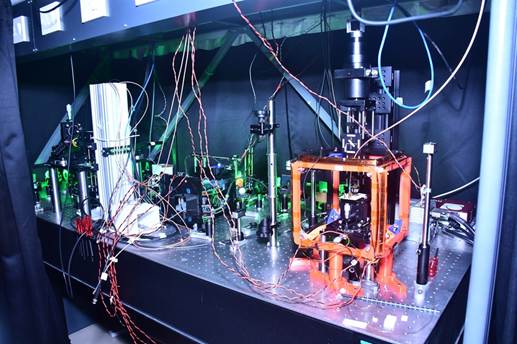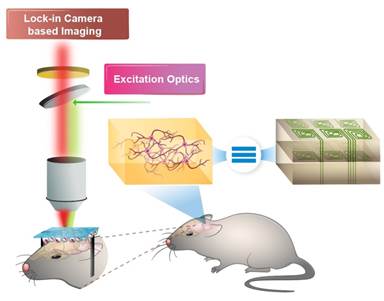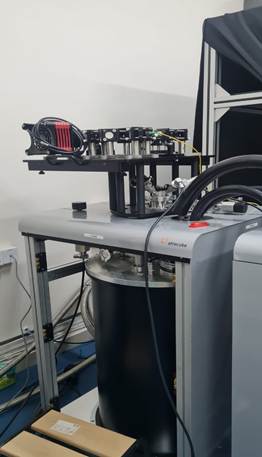Ministry of Science & Technology
Journey of NQM’s Quantum Sensing and Metrology Hub with lab grown technologies at IIT Bombay
प्रविष्टि तिथि:
17 FEB 2025 4:29PM by PIB Delhi
The Photonics and Quantum Sensing Technology Lab at IIT Bombay is ready with some technologies that can give the newly initiated Quantum Sensing and Metrology Hub a kick start into the world of quantum technologies.
These include the quantum diamond microscope and the portable magnetometer at the P-Quest Lab headed by Professor Kasturi Saha.
Prof Saha is the Project Director of the newly initiated Quantum Sensing and Metrology Hub, Qmet Tech Foundation, established by IIT Bombay under the National Quantum Mission (NQM).
The young Professor who along with her group explores and pushes the boundaries of precision metrology, sensing and imaging, using unprecedented opportunities presented by novel interdisciplinary research in fields like nano-photonics, classical and quantum information processing and life sciences, is now playing a crucial role in bringing together top minds, groundbreaking research, and transformative ideas to accelerate the quantum revolution.
The structure of Qmet, one of the four thematic hubs created under NQM being implemented by the Department of Science and Technology (DST), Government of India comprises of 16 institutes and 40 researchers located across India who are working with a shared sense of purpose to achieve the common goal through collaboration, cooperation, and effective communication.
It aims to bridge fundamental research and practical applications in Quantum Sensing and Metrology—one of the four focus areas under NQM.
Diamonds are a major focus of Prof Saha’s research. Her team works with defects called Nitrogen Vacancy (NV) centre in diamond which are very precise magnetic field and temperature sensors. She manipulates them to make systems that can probe your neurons or delve into your cells.
When the NV centres in the quantum diamond microscope being developed in Prof Saha’s lab are excited with fluorescent green light, they emit red light. This NV centre defect exhibits a unique "spin" property. The spins couple with magnetic fields and they emit red light. So, they essentially act like ultra-sensitive magnetic field sensors.
The team aims to use the quantum diamond microscope to enable non-destructive testing of semiconductor chips by mapping magnetic field in 3D layers within an encapsulated chip.
They are also trying to extend this application into different other domains like biological sensing. They probe into neuronal cultures that exchange electrical pulses resulting in magnetic fields associated with them.
These magnetic fields, albeit extremely small, can be measured to trace the location of the neurons and this measurement can help identify and correlate how the neurons are actually interacting with the magnetic fields by producing single neuron resolution. This could be one of the potential ways in which one can really go to the fundamental limits of magnetic field sensitivity.
Diamonds mined in India, which Professor Saha specializes in, have a rich history dating back to ancient times and are renowned for their exceptional gemstone quality. The diamonds used for quantum applications, are however lab-grown CVD diamonds.
The team is working with a lot of diamond companies to enable indigenous, development of diamond within India for quantum applications. Enabling benchmarking of diamond samples is a crucial step in the process. In it they measure the different properties of the diamond NV spins or their lifetime technically called coherence time.
Apart from this they are working on the portable magnetometer that can be converted to chips which can be used in drones for surveillance.
In their dilettante with fundamental physics, the team is also looking at different kinds of magnetic materials to explore their viability as quantum materials. The set up they have developed will help them understand how different materials work, form magnetic maps extending even to the video of a magnetic map and understand the direction of the magnetic field being generated.
This opens up scope of commercialising it under the NQM. Improving the sensitivity of such a set up could help imaging of neurons. Their goal under NQM is to provide the highest kind of spatial resolution possible for a quantum microscope by pushing the sensitivity down absolutely to the fundamental limits and understanding the noise constraints that need to be corrected. In this manner, they plan to develop practical quantum devices via design and experimentation, thus connecting quantum theory to engineering applications.

Quantum Diamond Microscope

Quantum sensing of mimicked neural activities

Set up for testing quantum materials
***
NKR/PSM
(रिलीज़ आईडी: 2104088)
आगंतुक पटल : 1156